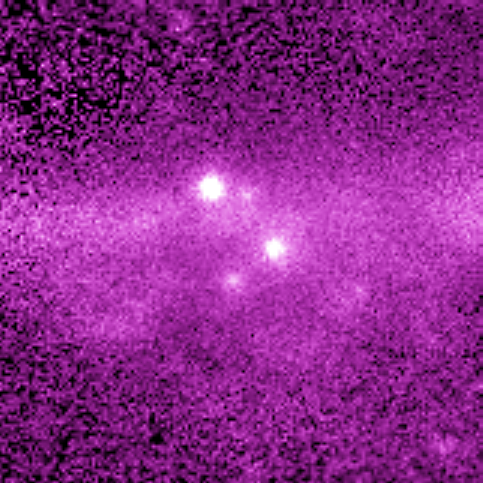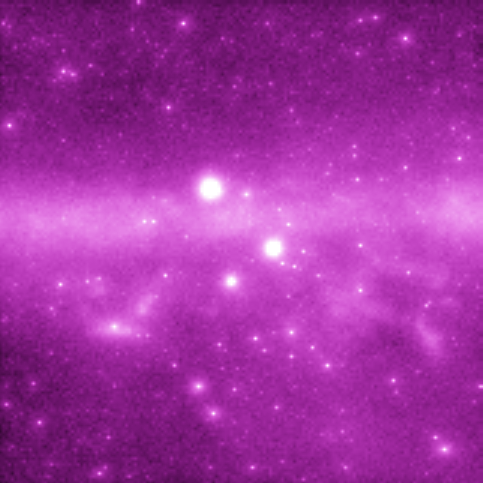Views of the Galactic Anticenter
The image on the left is a summation of EGRET data for CGRO Phases 1 through 5. The image on the right is a simulated image corresponding to a one-year all-sky survey with GLAST. Both show the intensity of gamma rays with energies above 100 MeV in an 80 degree x 80 degree (1.8 sr) field.
Technical Notes on the GLAST Simulation
The simulated image includes 1) the sources in the Third EGRET Catalog (Hartman et al. 1998, in press) 2) a diffuse Galactic background model (Hunter et al. 1997; Sreekumar et al. 1998), and 3) the diffuse isotropic background represented as many faint sources with a flux distribution based on Stecker & Salamon (1996).
The simulation used parameters for GLAST that are consistent with the specifications in the GLAST Science Requirements Document. The sky survey is assumed to have been performed in "step-rocking" mode, and the resulting exposure is uniform. The off-axis variation of the effective area and the distribution of observing time with inclination angle have been factored into the exposure calculation. An overall observing time efficiency of 90% was assumed. The resulting exposure (energy-weighted for assumed E-2 spectra) is 3.37x1010 cm2 s. The effective PSF for the instrument was derived on the assumption of an E-2 input spectrum using just the on-axis response and all sources are assumed to have spectral index -2.
The underlying diffuse emission model nominally has 30' angular resolution. This is narrow relative to the broad tails of the PSF for this energy range and does not appreciably affect the resulting resolution of the survey image. In addition to the broad band of emission from the outer parts of the Galactic disk, the diffuse emission also shows the Orion A&B-Mon R2 and Taurus-Auriga molecular cloud complexes.
The brightest 50 or so point sources are from the Third EGRET Catalog. The cataloged positions of the sources were used. In most cases, the cataloged fluxes were scaled down by a factor of 2 or more. Many of the sources were detected by EGRET in flaring states, so the cataloged entries (corresponding to the viewing period or periods for which the detection was most significant) do not represent time-averaged fluxes. Some artistic license was used in scaling the cataloged fluxes to produce an image that was visually more or less consistent with the EGRET intensity map for Phases 1-5.
The ensemble of faint sources added to the image has with overall flux equal to the isotropic diffuse intensity (assumed to be 1.5x10-5 cm-2 s-1 sr-1). The distribution of these sources in flux was fit to the relation in Figure 2 of Stecker & Salamon (1996). The maximum flux for these background sources 'was set at 5x10-8 cm-2 s-1, near or below the EGRET detection threshold. The distribution was cut off at 3x10-10 cm-2 s-1 to make the background intensity equal 1.5x10-5 cm-2 s-1 sr-1. The overall density of background sources is about 4 per deg2, or one per 0.5 deg x 0.5 deg resolution element of the model. The entire field contains 26,200 of the faint, background sources, the majority of which are below the sensitivity limit of GLAST.
The projection of the spherical coordinate system into the rectangular map was taken into account in generating the image. The brighter sources at high latitudes look somewhat extended in longitude as a result.




